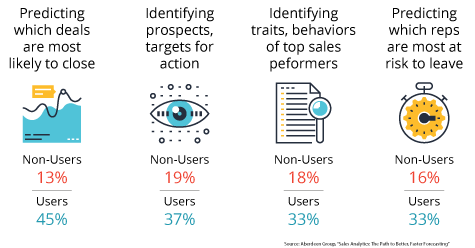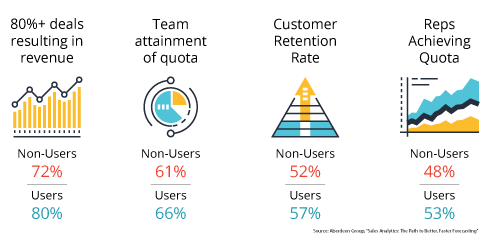Sales analytics tools help sales leaders to better leverage historical evidence about sales activities, wins, and losses which enables them to make smarter decisions about current opportunities in the pipeline. Sales analytics applications are increasingly used by sales leaders in the industry to leverage big data and predictive analytics to more efficiently run their part of the business.
Leveraging big data insights is especially important to understand overall sales performance. Sales analytics gives sales teams the opportunity to improve their own job performance and other benefits such as weighting opportunities to more effectively predict outcomes and coaching sales teams to improve the productivity and efficiency of the sales function.
Sales Analytics Can Make Everyone Better at Their Jobs
Real-time analytics tells sales managers how their team is performing and reveals gaps in the process where efficiency and productivity can be improved. It can also highlight who is underperforming, which is essential to possibly understand where deal slippage may be occurring.
The use of real-time analysis of current opportunities can be used to guide sales reps toward the messaging and tactics for individual deals currently in play. Top sales leaders apply data-oriented weighting to sales deals at one or more points throughout the life cycle and use sales analytics insights to coach sales teams effectively.
Apply Weighting to Sales Deals
Top sales leaders apply data-oriented weighting to sales deals at one or more points throughout the life cycle. After all, circumstances may change for a deal from the qualification stage through to close. Applying weighting to sales data lets managers decide when an opportunity is still good to go and when an opportunity is a no-go.
The advantage for companies that use analytics is to determine which deals are worth pursuing and which aren’t. This proves to be beneficial because resources can be allocated for more likely to close deals, and sales representatives aren’t wasting their own time chasing deals that aren’t going to close. Of course, this isn’t about reducing the number of opportunities in the pipeline, but rather to fill the pipeline with high-quality opportunities that have been weighted and can be considered more predictable.
Weighting opportunities are also important when it comes to forecasting. Forecasting is often thought of as trying to “predict the future,” but most of the time the opportunities these predictions are built on aren’t based on data or evidence. When sales opportunities are weighted throughout the sales lifecycle, predictive analytics provides real-time information about each opportunity as it progresses, which improves pipeline visibility and can have an improvement on overall company performance, not to mention improve forecast accuracy.
This approach also reduces subjectivity and bias throughout the process. Sales leaders have more clarity around which data-driven factors are reliable at predicting how sales opportunities will turn out. An analytics tool that includes predictive capability and analyzes historical sales activity to identify commonalities within current deals can predict more or less likely outcomes. Those who use analytics tools see the benefits: they are better at predicting which deals are more likely to close, identifying prospects and identifying traits and behaviors at a higher rate than non-users.

Improve How You Coach Your Sales Team
When performance data is available, it’s much easier for sales leaders to coach sales team and effectively think about what can be done to improve overall performance and sales effectiveness. If management is guessing and shooting in the dark, it’s likely that attention will be focused on the wrong KPIs.
When sales teams are coached properly and understand what is effective and what isn’t, they can develop a process that will lead to greater sales effectiveness. Sales leaders have the opportunity and tools to coach sales teams as deals progress in real-time and help improve messaging and tactics throughout to secure the deal.
The Results Are in
Organizations that adopt sales analytics solutions outperform those who don’t time and time again. KPIs such as team attainment of quota and customer retention are stronger, as well as year-over-year trends such as company revenue growth. These organizations have better business outcomes that justify an analytics investment and strengthen the organization as a whole.

Making the process more predictable enables sales leaders to invest their time in the right opportunities and coach those sales representatives who are not performing up to par.
What types of KPIs are important for your organization to track? Vortini has a large store of KPIs for organizations to customize and track sales effectiveness, contact us to get the discussion started about your specific requirements and needs.
Jess is a communications professional and Vortini’s lead content/web developer. Her current interests lie in the intersection of sales technology and machine learning. In her free time she reads a book-a-week, practices yoga, and is an avid gardener.

